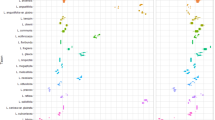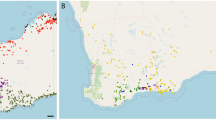Abstract
Two hypotheses which might explain a recent increase in the incidence of verticillium wilt of chrysanthemums in glasshouses in the Netherlands were investigated, viz whether selection for increased resistance to elevated temperatures has occurred due to frequent steaming of soils in the glasshouses, or whether the strains of Verticillium dahliae occurring in chrysanthemum glasshouses are particularly virulent towards this host. Following artificial inoculation, five isolates of V. dahliae from chrysanthemum were pathogenic on chrysanthemum but five isolates from potato were non-pathogenic for this host. When inoculated onto potato plants, all isolates caused early senescence with no significant difference between the two groups of isolates. In amplified fragment length polymorphism analysis, the potato isolates formed a cluster distinct from all other isolates. As a group the chrysanthemum isolates were no more diverse than the potato isolates but did not form a cluster distinct from 12 other isolates tested. This suggests that high pathogenicity to chrysanthemum has developed on several occasions but that the group of potato isolates were possibly monophyletic. Microsclerotia produced in vitro from the chrysanthemum isolates had significantly lower average lethal temperature tolerance than those from the five potato isolates suggesting that being able to resist the effects of soil sterilisation by steam is not a factor in wilt of chrysanthemums in the Netherlands.



Similar content being viewed by others
References
Ashworth, L. J. (1983). Aggressiveness of random and selected isolates of Verticillium dahliae from cotton and the quantitative relationship of internal inoculum to defoliation. Phytopathology, 73, 1292–1295.
Barbara, D. J., & Clewes, E. (2003). Plant pathogenic Verticillium species: How many of them are there? Molecular Plant Pathology, 4, 297–305.
Bhat, R. G., & Subbarao, K. V. (1999). Host range specificity in Verticillium dahliae. Phytopathology, 89, 1218–1225.
Bollen, G. J. (1985). Lethal temperatures of soil fungi. In C. A. Parker, A. D. Rovira, K. G. Moore, P. T. Wong, & J. F. Kollmorgen (Eds.) Ecology and management of soil-borne plant pathogens (pp. 191–193). St. Paul: American Phytopathological Society.
Campbell, C. L., & Madden, L. V. (1990). Introduction to plant disease epidemiology p. 244. New York: Wiley.
Carder, J. H., & Barbara, D. J. (1994). Molecular variation within some Japanese isolates of Verticillium dahliae. Plant Pathology, 43, 947–950.
Castejón-Muñoz, M., & Bollen, G. J. (1993). Induction of heat resistance in Fusarium oxysporum and Verticillium dahliae caused by exposure to sublethal heat treatments. Netherlands Journal of Plant Pathology, 99, 77–84.
Collins, A., Okoli, A. N., Morton, A., Parry, D., Edwards, S. G., & Barbara, D. J. (2003). Isolates of Verticillium dahliae pathogenic to crucifers are of at least three distinct molecular types. Phytopathology, 93, 364–376.
Fordyce, C., & Green, R. J. (1963). Alteration of pathogenicity of Verticillium albo-atrum var. menthae. Phytopathology, 53, 701–704.
Francl, L. J., Rowe, R. C., Riedel, R. M., & Madden, L. V. (1987). Effects of three soil types on potato early dying disease and associated yield reduction. Phytopathology, 77, 159–166.
Harris, D. C., Yang, J. R., & Ridout, M. S. (1993). The detection and estimation of Verticillium dahliae in naturally infested soil. Plant Pathology, 42, 238–250.
Horner, C. E. (1954). Pathogenicity of Verticillium isolates to peppermint. Phytopathology, 44, 239–242.
Karapapa, V. K., Bainbridge, B. W., & Heale, J. B. (1997). Morphological and molecular characterization of Verticillium longisporum comb. nov., pathogenic to oilseed rape. Mycological Research, 101, 1281–1294.
Mol, L., van Halteren, J. M., Scholte, K., & Struik, P. C. (1996). Effects of crop species, crop cultivars and isolates of Verticillium dahliae on the population of microsclerotia in the soil, and consequences for crop yield. Plant Pathology, 45, 205–214.
Nei, M., & Li, W.-H. (1979). Mathematical model for studying genetic variation in terms of restriction endonucleases. Proceedings of the National Academy of Sciences of the United States of America, 76, 5269–5273.
Pegg, G. F., & Brady, B. L. (2002). Verticillium wilts p. 357. New York: CABI.
Rodríguez-Jurado, D., Blanco-López, M. A., Rapoport, H. F., & Jiménez-Díaz, R. M. (1993). Present status of Verticillium wilt of olive in Andalusia (Southern Spain). EPPO Bulletin, 23, 513–516.
Strausbaugh, C. A. (1993). Assessment of vegetative compatibility and virulence of Verticillium dahliae isolates from Idaho potatoes and tester strains. Phytopathology, 83, 1253–1258.
Author information
Authors and Affiliations
Corresponding author
Rights and permissions
About this article
Cite this article
Ispahani, S.K., Goud, J.C., Termorshuizen, A.J. et al. Host specificity, but not high-temperature tolerance, is associated with recent outbreaks of Verticillium dahliae in chrysanthemum in the Netherlands. Eur J Plant Pathol 122, 437–442 (2008). https://doi.org/10.1007/s10658-008-9275-4
Received:
Accepted:
Published:
Issue Date:
DOI: https://doi.org/10.1007/s10658-008-9275-4




